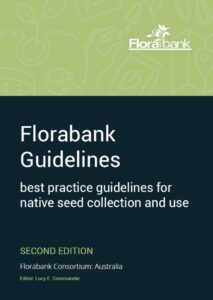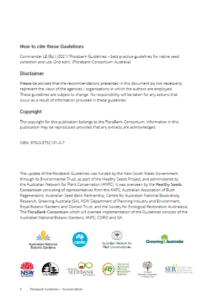best practice guidelines for native seed collection and use
The second edition of the Florabank Guidelines is now online!
Seeds of native plants are needed to restore ecological communities that have been degraded and are unable to recover on their own.
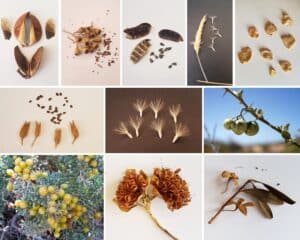
Photos: L Commander & Alice Quarmby
These communities may have been adversely affected by too frequent fires, invasive species or overgrazing, or have been completely cleared, such as former agricultural fields or mine sites.
But, restoration using seed is not always successful.To guide seed-based restoration, the Florabank Guidelines were published in 1999.
The Florabank partners were Greening Australia, CSIRO Forestry and Forest Products through the Australian Tree Seed Centre, and the Australian National Botanic Gardens, and FloraBank was funded by Bushcare – a program of the Commonwealth Government’s Natural Heritage Trust.
Since the first edition of the Guidelines, 20 years of practical experience and research has led to new information about seed storage and propagation, advances in technology and equipment, and increased understanding about provenance.
The update
Hence, an update of the Florabank Guidelines is much needed to guide the industry. In 2019, the NSW Government, through its Environmental Trust funded the Healthy Seeds project, which includes updating the Guidelines.
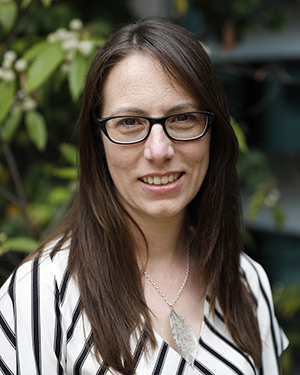
Florabank Guidelines Project Manager, Dr Lucy Commander
ANPC Project Manager, Dr Lucy Commander, has led a team of national and international experts to update the information.
This process involved forming a reference group, deciding on the list of modules, inviting authors, drafting each module, sending the modules out for peer review, incorporating the reviewers comments, and sending the content to a graphic designer for final layout. A launch and workshops are anticipated in the near future to communicate the content
Content
The modules follow each aspect of the seed supply chain:
- seed sourcing to collection;
- production areas;
- processing cleaning and extraction;
- drying and storage;
- quality testing;
- germination and dormancy;
- enhancement technologies;
- nursery propagation;
- direct seeding.
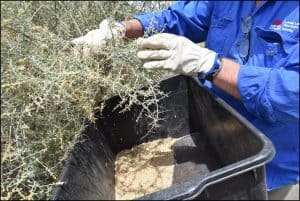
Collecting Nitre Goosefoot (Chenopodium nitrariaceum) seed. (Photo: Sue Logie)
In addition, modules on indigenous knowledge; records and databases; policy and licensing; and tips for buying and selling seed support each step in the supply chain.
To see the table of contents click here. This document also includes the ISBN.
How to cite these Guidelines
Commander LE (Ed.) (2021) ‘Florabank Guidelines – best practice guidelines for native seed collection and use (2nd edn).’ (Florabank Consortium: Australia)
All those involved in any aspect of seed based restoration, from licencing and policy, collection and testing, seeding and planting, to research and conservation are encouraged to read the updated guidelines. They are now available online for free on the Florabank website.
Watch Lucy Commander’s presentation below on the update of the Florabank Guidelines
(which was to be presented at the postponed Australasian Seed Science Conference in Canberra in April 2020).
Complementary publications
The Florabank Guidelines focuses on seed use in restoration, which complements the Translocation Guidelines, which focuses on threatened species, and the Germplasm Guidelines, which focuses on ex situ conservation.
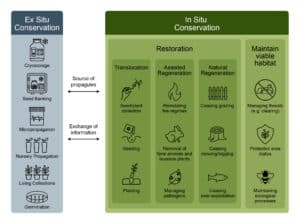
In situ and ex situ activities can support each other, for instance, ex situ research on germination can support actions like seeding and planting, and in situ seed collection can support ex situ seedbanking and living collections. (Figure prepared by Craig Miskell, CAM Graphics)
Thanks to…
The ANPC wishes to thank the consortium of partners involved in the project, all those who have volunteered their time to provide input into the FloraBank Guidelines.
The FloraBank Guidelines update is an outcome of the Healthy Seeds Project
Follow our progress
For project updates, join the ANPC, subscribe to ANPC News (our free, monthly e-newsletter), follow us on twitter and facebook and watch our YouTube videos.
You may also be interested in reading/listening to…
Restoration Seed Ecology with Dr Lucy Commander – Steam Powered;
Podcast: Farming wildflowers; the future of restoration and native seed;
Dr Paul Gibson-Roy talks about seed supply for restoration projects;
ANPC’s Australian Native Seed Survey Report released;
Bushfires resources page


